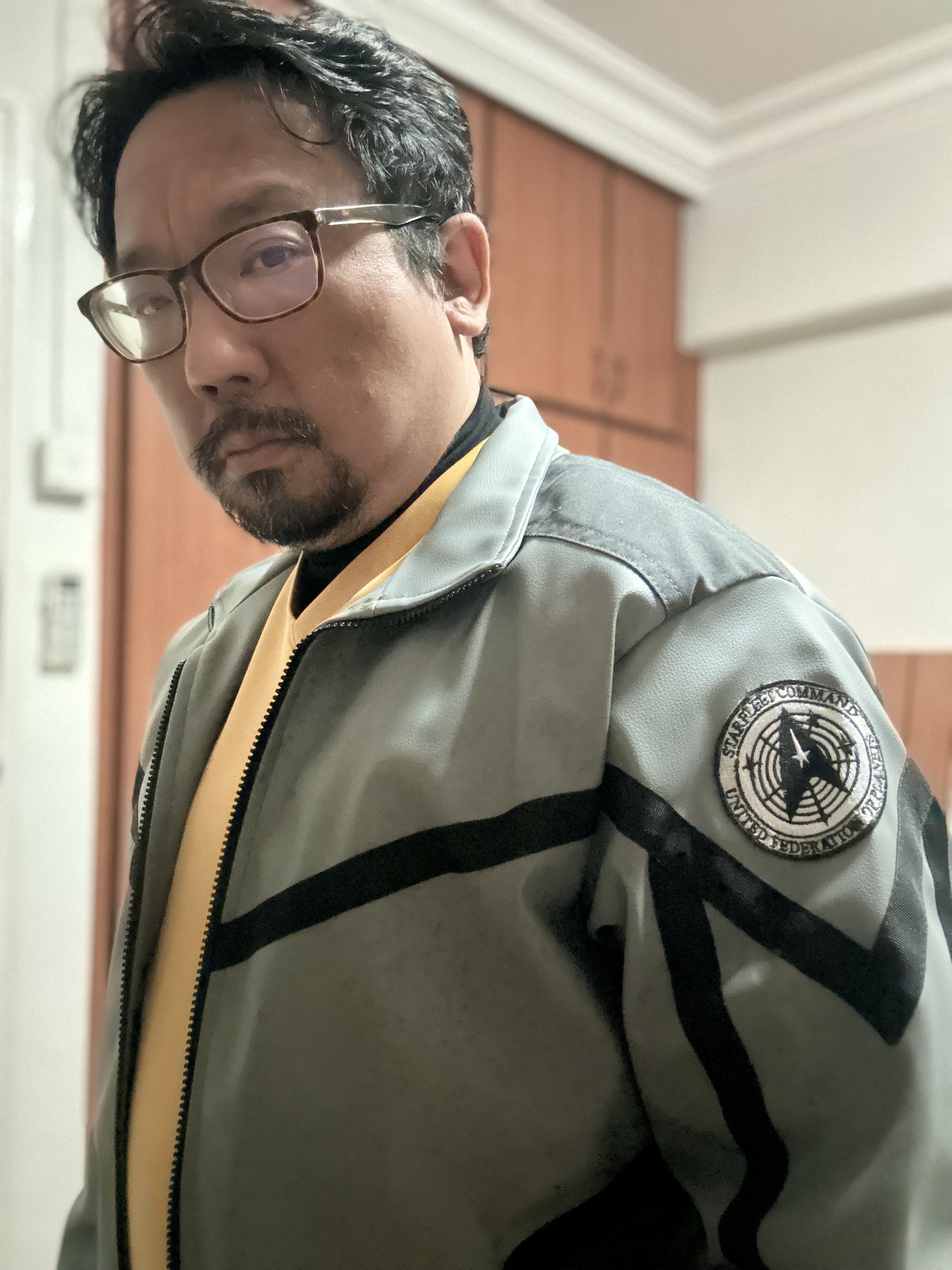The title refers both to the deceptions that Spock and the crew engage in to cover what happens to him, as well as Pike’s desperate attempt to play the game “charades” as a delaying tactic.
The episode was written by supervising producer Kathryn Lyn and showrunner Henry Alonzo Myers. Lyn wrote what is the best LD episode to date, the amazing “wej Duj”. This explains the LD-esque type of observational humor in the dialogue.
Chapel’s personal log is stardated 1789.3. She and Spock are in the Vulcan system, to survey the moon Kherkov on the far side of the sector. It is unclear if this means that Kherkov is in the Vulcan system itself, or when she means sector she means the system. Star Trek has always been vague about how large a sector is, and in TOS days even how large a quadrant is. In Geoffrey Mandel’s Star Charts, a sector is defined as a cube of 20 ly. Kherkov was inhabited by a long vanished civilization and rumored to have had advanced medical knowledge.
What the script means by “sub-impulse” speeds is also unclear, as impulse operations are already sublight in nature. Perhaps this merely means at low impulse speeds.
M’Benga mentioned Korby’s principles of archeological medicine. Roger Korby, known as the Pasteur of Archeological Medicine, would eventually become affianced to Chapel, vanish on the frozen planet of Exo III and turn up five years later as an android (TOS: “What are Little Girls Made Of?”).
Spock is headed for Deck 12, which, according to Franz Joseph’s Enterprise deck plans, is in the interconnecting dorsal section, and contains an observation lounge.
M’Benga has been helping Spock with controlling his emotions (SNW: “The Broken Circle”) after he let them loose in SNW: “All Those Who Wander”.
Pike claims that you can tell the difference between fresh and synthesized herbs. At this point in history, starships use food synthesizers, not replicators, although the difference between the two processes is not entirely clear. The herb Pike pushes on Spock is basil.
Spock says he uses nasal suppressants to block out the smell of humans, which Vulcans take getting used to. In ENT: “The Andorian Incident”, T’Pol uses a regularly injected nasal numbing agent to help with the same issue, although she also partially acclimatizes.
Lieutenant Sam Kirk makes his first in-universe appearance since SNW: “Children of the Comet”. An alternate timeline version did appear in SNW: “A Quality of Mercy”.
Sam mentions increased sunspot activity in Eridani B. 40 Eridani is a star system comprised of three suns - Eridani A, B and C. It was established in Franz Joseph’s Star Fleet Technical Manual as Vulcan’s system. It is 16 ly away, consistent with ENT’s mention of Vulcan’s distance from Earth. In 2018, an exoplanet was apparently discovered orbiting Eridani A which some fans wanted named Vulcan, but recently the discovery of 40 Eri b turned out to be a mistake.
A Vulcan ceremonial engagement dinner is known as a V’Shal dinner. Spock mentions that he is “still” not speaking with his father. In TOS: “Journey to Babel” it is revealed that the two fell out after Spock elected to join Starfleet rather than the Vulcan Science Academy, and had not spoken since 2249. Amanda assumed that it was because Sarek disapproved of Starfleet as an organization, but the reasons are a bit more complicated, as we find out in DIS: “Lethe”.
T’Pring’s parents here are T’Pril and Sevet. In the novel Vulcan’s Glory, T’Pring’s father was named Solen.
Spock’s (almost) use of the “f” word is of course for comic effect: the first time the expletive was used in Trek was in DIS: “Choose Your Pain”, used by Tilly and Stamets.
The alien entity identifies themselves as Yellow, of Kherkov. The rupture was a transport tunnel, which explains its visual similarity with the Bajoran wormhole (DS9). Yellow is pretty much a Customer Service operator who just wants to get you off the line.
Aliens not knowing how humans are put together is an old trope - we first see it in Trek in TOS: “The Cage”, when Vina’s disfigured form is explained as the Talosians not knowing what a human looked like before they healed her. A modern example can be seen in Doctor Who’s “The Empty Child/The Doctor Dances”.
Chapel is working to reverse Spock’s genetic alteration. As we saw in SNW: “Strange New Worlds”, she has an expertise in modifying genomes, although that was temporary and for the purpose of disguising away teams.
The enticing aroma of bacon - at least to humans - is due to the Maillard Reaction, which triggers our body’s natural cravings for salt and fat. Spock’s fascination and inexperience with bacon is also because post-Surakian Vulcans are vegetarian. As a human, Spock appears to have forgotten that. Spock would eat meat in TOS: “All Our Yesterdays” when transported thousands of years into the past and reverting to the Vulcans of those days.
M’Benga describes the Kherkovians as inscrutable, interdimensional beings that don’t experience space and time the way we do. They sound more and more like they could be related to the Prophets.
Pike tells Amanda that Pelia sends her regards but she’s off dealing with their “dilithium shortage”. It was established in SNW: “The Broken Circle” that Amanda was the first person to whom Pelia revealed her status as a Lanthanite. Dilithium was always a scarce resource in Trek, and its shortage would eventually lead to more dire consequences in the 31st Century. Pelia’s penchant for “acquiring” antiques was established in SNW: “Tomorrow and Tomorrow and Tomorrow”.
Spock wears a beanie to conceal his (in this case) lack of ears. Spock first used such a hat to conceal his ears in TOS: “The City on the Edge of Forever”. Amanda says that Spock isn’t a practiced liar… yet. As we know, Spock will become a lot better at lying in future (TOS: “The Enterprise Incident”, ST II and ST VI being the most obvious examples aside from covert away missions).
The fake ears are probably the same kinds of ears Ethan Peck wears when made up as Spock. When teaching Spock how to act and sound Vulcan, Ortegas’ line about “Notice how I move my eyebrow but no other muscles in my face,” is very Beckett Mariner-like.
The V’Shal ritual starts with Spock making the bride’s family’s recipe for tea and serving it. Tuvok once served Vulcan tea to Captain Sulu (VOY: “Flashback”). Next is the Ritual of Awareness, when a young couple is made aware of all their faults and flaws. While a timer counts down, T’Pring’s parents will tell Spock all the things they think he is doing wrong. Last is the Mind Meld, where Amanda and Spock will share a memory of his childhood.
Spock’s open use of the mind meld and Pike and Una’s knowledge of it contradicts the first time it was used in TOS: “Dagger of the Mind” when he tells McCoy that it was a deeply private thing for Vulcans. He also said then that he had never used on a human before but here he says he’s used to seeing Amanda’s memories.
M’Benga says he has some gene therapy techniques he pulled from the Trinar. It’s not clear if he’s referring to a race or a ship, although closed captioning italicizes Trinar regression.
Pike has cooked traditional tevmel, but T’Pril criticizes the halak as not being fresh and being salted. Pike explains he uses salt to slow fermentation as starships run hotter than your typical Vulcan kitchen.
Ortegas says that she hates analogies because they’re never really like they say it is. Using analogies to make technobabble clearer (“It’s just like skipping a stone across a pond!”) is a time honored tradition in Star Trek.
T’Pring warns Spock not to rush the pouring of the tea or else the pomkot leaves will fail to bloom.
The interdimensional space the trio find themselves in reminds me, tonally, of when Dax and Sisko first entered the wormhole in DS9: “Emissary”. The Kerkhov they speak to this time is Blue, who notes that the complaint is lodged out of the response period. Chapel asks to speak with Yellow and is basically put on hold. Customer Service from hell, indeed.
The soundtrack during the Ritual of Awareness is underlaid with a slower version of the Vulcan fighting theme from TOS: “Amok Time”. During the meld, Amanda’s memory is of an ordinary day when she took Spock to school - the first time Vulcan children asked Spock to play with them.
Spock makes the excuse that he did not tell T’Pring because of the difficulty Vulcans have lying, but that can’t be true. A better explanation would have been that it was because she would be melding with T’Pril later and it might have been picked up. T’Pring also reminds Spock that they have shared katras (SNW: “Spock Amok”).
Spock and Chapel’s confession and clinch, of course, is in opposition to what happened in TOS: “The Naked Time”, but at this point, with the popularity of Jess Bush’s portrayal of the character and time travel shenanigans as an excuse, it’s a minor point that only the truly pedantic would even point out as part of their annotations.
M’Benga describes the Kherkovians as inscrutable, interdimensional beings that don’t experience space and time the way we do. They sound more and more like they could be related to the Prophets.
They sure had a concept of time on shutting out feedback about mistakes in their remedy.
who notes that the complaint is lodged out of the response period.
…
Well, to be fair I didn’t say they were the same as the wormhole aliens - just that they could be related.
There are certainly characteristics that remind me of them: especially their non-corporeality, reluctance to talk with outsiders, a wormhole-like transport tube and an interdimensional liminal space for communication. They may have a concept of linear time, but it’s mostly self-serving. They’re also condescending as hell, but that’s probably a characteristic of all ascended species.
that’s probably a characteristic of all ascended species.
I mean it has to be. Once you have factual evidence of a super-powerful species with great technology, doesn’t that have to cross your mind as to the order of things around you? I have to hope some group in the Federation has to have theories about what the Q could be doing to account for behaviors in the universe. Who knows what the Q does that has an unknown side-effect to humanity. Clearly the Bajorans considered the side-effects of their eternal beings next door, at least mystically.
As an addendum, T’Khut, Vulcan’s sister planet, is now canon.
https://twitter.com/timothypeel1/status/1680632707116675074?s=20
“[Vulcan’s sister] planet, shortchanged on the denser elements, was able to settle into an orbit with its partner that would seem, to those unfamiliar with the physics and densities involved, to bring it dangerously close to Vulcan. It rarely fails to look dangerous, especially when a Terran used to a small, cool, distant, silvery Moon, looks up at dusk to see a ruddy, bloated, burning bulk a third of the Vulcan horizon wide come lounging up over the edge of the world, practically leaning over it, the active volcanoes on its surface clearly visible, especially in dark phase. “Vulcan has no moon,” various Vulcans have been heard to remark: accurate as always, when speaking scientifically. “Damn right it doesn’t,” at least one Terran has responded: “It has a nightmare.””
- Diane Duane, Spock’s World


